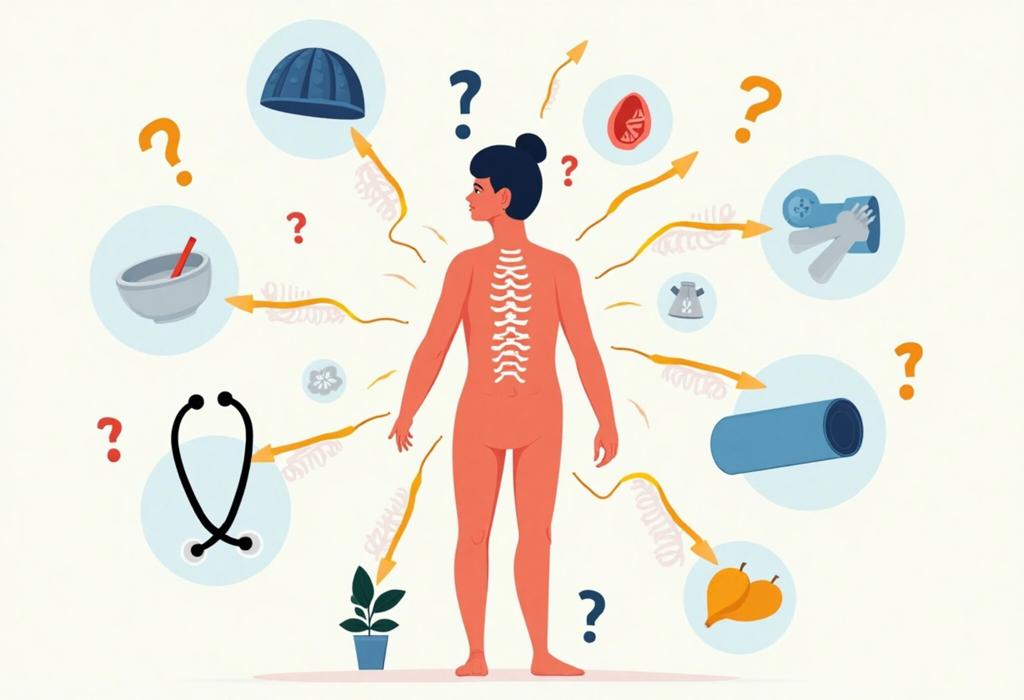For more details on this content, please review the step-by-step guide and frequently asked questions.
Chronic Pain: Signs and Subtleties

Step-by-Step Guide
What is Chronic Pain?
Chronic pain is defined as pain that lasts for more than three months. Unlike acute pain, which serves as a warning of injury or illness, chronic pain can occur without an identifiable source and persist even after the body has healed. It can affect various structures in the body, including the musculoskeletal system.
Common Signs of Chronic Pain
Recognizing chronic pain involves observing various signs. Common indicators include persistent aches or soreness, sharp or stabbing pain, increased sensitivity to pain, and difficulty in standing, walking, or maintaining usual daily activities. Emotional symptoms such as anxiety and depression may also accompany physical pain.
Different Types of Chronic Pain
Chronic pain can manifest in several forms, including nociceptive pain (arising from injury or damage to tissues), neuropathic pain (caused by nerve damage), and psychogenic pain (linked to psychological factors). Understanding the type of pain can assist in determining the most effective treatment.
Subtle Signs to Look For
Apart from the common signs, subtle symptoms may provide clues about chronic pain. These can include limited range of motion, fatigue, changes in sleep patterns, and alterations in mood. Patients may experience frustration or confusion due to the invisible nature of their pain.
Emotional and Psychological Aspects
Chronic pain doesn’t just affect the body; it also significantly impacts mental health. Feelings of isolation, anxiety, and depression can arise when individuals struggle to communicate their experiences to others. Recognizing these emotional responses is essential for comprehensive care.
Associated Conditions
Chronic pain often coexists with other health conditions such as arthritis, fibromyalgia, migraines, or other chronic illness. Understanding the relationship between these conditions and chronic pain can aid in more effective treatment and management strategies.
Diagnosis of Chronic Pain
Diagnosing chronic pain generally involves a thorough medical history review, physical examinations, and possibly imaging tests. Medical professionals may also use questionnaires to assess the intensity of the pain and its impact on daily life. It is essential to rule out other underlying health issues.
Creating a Pain Management Plan
A personalized pain management plan should include various approaches, such as medication (both over-the-counter and prescription), physical therapy, exercise, and cognitive behavioral therapy. Lifestyle changes, including stress management techniques and dietary modifications, can also play a crucial role.
Seeking Professional Help
Consulting healthcare providers, such as primary care doctors, pain specialists, or mental health professionals, is vital for chronic pain management. These experts can devise multi-disciplinary approaches to tackle both the physical and emotional components of pain.
Explore Alternative Treatments
Various alternative treatments could complement conventional pain management strategies. These include acupuncture, chiropractic care, herbal medicine, and massage therapy. Individuals should consult their healthcare providers before starting any alternative treatment method.
Utilizing Support Networks
Support groups can provide social support and understanding. Engaging with others facing similar challenges enables individuals to share experiences, coping strategies, and resources, which can aid in dealing with chronic pain.
Monitoring Progress
Keeping a pain diary can help individuals track their pain levels, triggers, and the effectiveness of various treatments. Regularly reviewing this information with healthcare providers can facilitate ongoing adjustments to the pain management plan.
Self-Care Practices
Incorporating self-care practices into daily routines is crucial for managing chronic pain. This might involve starting a gentle exercise routine, practicing relaxation techniques, and making time for hobbies and social activities to boost mental well-being.
Educating Yourself About Chronic Pain
Servicing yourself with knowledge about chronic pain can empower individuals to make informed decisions regarding their care. Reading reliable resources and staying informed about advances in pain management is crucial for long-term wellness.
Understanding Pain Medications
It's essential to be informed about different types of pain medications available, their potential side effects, and the risks of long-term use. Consulting healthcare professionals about appropriate medications and dosages is crucial for safe management.
Reducing Stress to Manage Pain
Stress can exacerbate chronic pain. Exploring stress-reduction techniques, such as meditation, mindfulness, yoga, or deep-breathing exercises, can be beneficial. Identifying stress triggers and learning coping strategies is crucial for better pain management.
Understanding Importance of Sleep
Quality sleep is essential for healing and pain management. Chronic pain can disrupt sleep patterns, leading to more pain and fatigue. Establishing good sleep hygiene practices and seeking treatment for any sleep disorders is important.
Lifestyle Changes for Pain Management
Incorporating lifestyle changes—such as maintaining a balanced diet, stopping smoking, and limiting alcohol consumption—can effectively manage chronic pain. Nutrition plays a significant role in overall health and helps in maintaining optimal body function.
Communicating with Healthcare Providers
Effective communication with healthcare providers is vital for receiving personalized care. Be clear about your pain experiences, including how it affects daily life. Discuss treatment responses and articulate preferences for managing your pain.
Developing a Resilient Mindset
Building resilience is crucial for anyone managing chronic pain. Fostering a positive mindset, engaging in problem-solving, and employing healthy coping strategies can empower individuals to navigate their pain journeys more effectively.








